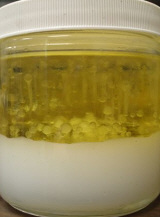



Fatty Fuels: A Potion of Poultry Power
US - Chemical engineering researchers at the University of Arkansas have been investigated the secrets behind converting chicken fat into biodiesel fuel with supercritical methanol. |
| A jar shows the type of tall oil fatty acids that graduate student Brent Schulte worked with to create biodiesel. |
The new study also successfully converted tall oil fatty acid, a major by-product of the wood-pulping process, into biodiesel at a yield of greater than 90 percent, significantly advancing efforts to develop commercially viable fuel out of plentiful, accessible and low-cost feedstocks and other agricultural by-products.
"Major oil companies are already examining biodiesel as an alternative to petroleum," said R.E. "Buddy" Babcock, professor of chemical engineering. "With the current price of petroleum diesel and the results of this project and others, I think energy producers will think even more seriously about combining petroleum-based diesel with a biodiesel product made out of crude and inexpensive feedstocks."
Under Babcock's guidance, Brent Schulte, a chemical-engineering graduate student in the university's College of Engineering, subjected low-grade chicken fat, donated by Tyson Foods, and tall oil fatty acids, provided by Georgia Pacific, to a chemical process known as supercritical methanol treatment. Supercritical methanol treatment dissolves and causes a reaction between components of a product - in this case, chicken fat and tall oil - by subjecting the product to high temperature and pressure. Substances become "supercritical" when they are heated and pressurized to a critical point, the highest temperature and pressure at which the substance can exist in equilibrium as a vapor and liquid. The simple, one-step process does not require a catalyst.
Schulte treated chicken fat and tall oil with supercritical methanol and produced biodiesel yields in excess of 89 and 94 percent, respectively. With chicken fat, Schulte reached maximum yield at 325 degrees Celsius and a 40-to-1 molar ratio, which refers to the amount of methanol applied. The process also produced a respectable yield of 80 percent at 300 degrees Celsius and the same amount of methanol. At 275 degrees Celsius and the same amount of methanol, the process was ineffective. Ideal results using tall oil fatty acid were achieved at 325 degrees Celsius and a 10-to-1 molar ratio. At 300 degrees Celsius and the same amount of methanol, the conversion produced a yield of almost 80 percent. Again, at 275 degrees Celsius, the process was ineffective.
Previous efforts, including a study two years ago by another one of Babcock's graduate students, to make biodiesel out of low-cost feedstocks - as opposed to refined oils - have used one of two conventional methods, base-catalyzed or acid-catalyzed esterification. Although successful at producing biodiesel, these conventional methods struggle to be economically feasible due to long reaction times, excessive amounts of methanol required and/or undesired production of soaps during processing.
* "it dissolves the feed material and eliminates the need for the base catalyst, we now do not have the problems with soap formation and loss of yield. The supercritical method actually prefers free fatty acid feedstocks." |
|
said R.E. "Buddy" Babcock, professor of chemical engineering.
|
"The supercritical method hit the free fatty-acid problem head on," Babcock said. "Because it dissolves the feed material and eliminates the need for the base catalyst, we now do not have the problems with soap formation and loss of yield. The supercritical method actually prefers free fatty acid feedstocks."
Biodiesel is a nonpetroleum-based alternative diesel fuel that consists of alkyl esters derived from renewable feedstocks such as plant oils or animal fats. The fuel is made by converting these oils and fats into what are known as fatty acid alkyl esters. The conventional processes require the oils or fats be heated and mixed with a combination of methanol and sodium hydroxide as a catalyst. The conversion process is called transesterification.
Most biodiesel is produced from refined vegetable oils, such as soybean and rapeseed oil, which are expensive; they generally account for 60 to 80 percent of the total cost of biodiesel. Due to these high feedstock prices, biodiesel production struggles to be economically feasible. Currently, as Babcock alluded, biodiesel cannot compete with petroleum diesel unless the per-gallon price of diesel remains higher than $3. For these reasons, researchers recently have focused efforts on less refined and less-expensive feedstocks as a more viable competitor to conventional diesel.
Biodiesel has many benefits. In addition to reducing U.S. dependence on foreign oil, it is better for the environment than purely petroleum-based products. As a renewable, biodegradable and thus carbon-neutral material, biodiesel does not contribute to greenhouse gases. In fact, it decreases sulfur and particulate-matter emissions. It also provides lubrication for better-functioning mechanical parts and has excellent detergent properties.
"Biodiesel provides an effective, sustainable-use fuel with many desirable properties," Schulte said. "In addition to being a renewable, biodegradable and carbon-neutral fuel source, it can be formed in a matter of months from feedstocks produced locally, which promotes a more sustainable energy infrastructure. It also decreases dependence on foreign oil and creates new labor and market opportunities for domestic crops."
Schulte worked with Ed Clausen, professor of chemical engineering and holder of the Ray C. Adam Chair of Chemical Engineering, and Michael Popp, professor of agricultural economics, in addition to Babcock. Schulte's study, which led to his master's thesis and is available upon request, was supported by the University of Arkansas Mack-Blackwell Rural Transportation Center. His work was awarded first place at the inaugural Admiral Jack Buffington Poster Paper Contest sponsored by the transportation center at its annual advisory board meeting.
Further Reading
|
|
- Go to our previous news item on this story by clicking here. |









